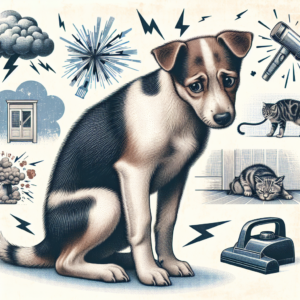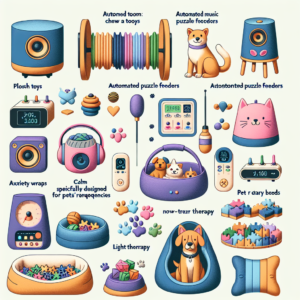- Article-at-a-Glance
- The Growing Need for Advanced Pet Health Monitoring
- How AI Wearables Offer a Window into Senior Pet Wellness
- GPS Trackers with Health Monitoring Features
- Activity Trackers Customized for Older Pets
- Smart Collars for Continuous Vital Signs Analysis
- Behavioral Change Detection Wearables
- Choosing the Right Device for Your Pet's Needs
- Installation and Calibration for Accurate Data
- Interpreting the Data to Enhance Pet Care
- Preventive Health Measures Based on Wearable Data
- Personalized Exercise and Diet Plans
- Staying Ahead of Age-Related Conditions
- Enhanced Comfort Through Automated Environmental Adjustments
- How AI Processes Pet Health Data
- Making Sense of Trends and Alerts
- Sharing Information with Your Vet
- Are AI-Powered Wearables Safe for My Senior Pet?
- How Often Should I Check the Wearable Device Data?
- Can AI Wearables Replace Regular Vet Check-Ups?
- Will My Pet Be Comfortable Wearing Technology?
- What If My Pet Has Existing Health Issues?

Article-at-a-Glance
- AI wearables provide real-time health monitoring for senior pets.
- These devices can track activity, monitor vital signs, and detect behavioral changes.
- Setting up the wearable involves choosing the right device, installing it, and interpreting the data.
- AI technology can help create personalized care plans for diet and exercise.
- Data from wearables should be shared with veterinarians for comprehensive care.
Revolutionizing Senior Pet Care with AI Wearables
As our cherished pets enter their golden years, their health needs become more complex. Traditional methods of care may not always catch the early signs of age-related issues. But technology is stepping up to the challenge. AI-powered wearables are not just gadgets; they’re tools that provide insights into our pets’ well-being, helping us to take proactive steps in managing their health.
The Growing Need for Advanced Pet Health Monitoring
With pets living longer thanks to better nutrition and veterinary care, age-related conditions such as arthritis, heart disease, and cognitive decline are more prevalent. We need advanced solutions to monitor their health and ensure they age gracefully. AI-powered wearables are the answer, offering a level of detail and foresight that was previously unattainable.
How AI Wearables Offer a Window into Senior Pet Wellness
Imagine a device that can learn your pet’s normal behavior patterns and alert you to any deviations. That’s what AI wearables do. They use sensors to monitor activity levels, sleep quality, and even vital signs like heart rate and temperature. This data is then processed by AI algorithms to detect any concerning changes, providing a window into your pet’s wellness that is always on and always vigilant.
Top AI Wearable Devices for Senior Pets
Let’s dive into some of the leading AI wearable devices designed to cater to the nuanced needs of senior pets.
GPS Trackers with Health Monitoring Features
These devices are not just for finding a lost pet. They can monitor activity levels, showing how much exercise your senior pet gets. This is crucial for managing weight and joint health.
Activity Trackers Customized for Older Pets
Activity trackers can be set with thresholds tailored to your pet’s age and breed. They ensure your senior pet isn’t overexerting themselves, which is especially important for those with heart conditions or arthritis.
- Select a tracker with adjustable sensitivity levels.
- Ensure it has a user-friendly interface for monitoring.
- Look for a comfortable and secure fit to accommodate your pet’s size.
Most importantly, these devices should be lightweight and unobtrusive, ensuring they don’t add any discomfort to your pet’s daily routine.
Smart Collars for Continuous Vital Signs Analysis
Smart collars go beyond tracking location. They continuously monitor vital signs like heart rate and respiration, which can be indicative of pain or distress in senior pets. Such early detection is invaluable for timely veterinary intervention.
Behavioral Change Detection Wearables
Behavioral changes can be subtle and gradual, often going unnoticed until they become more serious. Wearables that detect these changes can alert pet owners to early signs of cognitive decline or other health issues, allowing for early intervention.
Example: A smart collar that detects reduced movement and increased sleep patterns could indicate the onset of arthritis or other painful conditions.
Now that we understand the types of AI-powered wearables available, let’s move on to setting up the device for your senior pet, interpreting the data, and ultimately, improving their quality of life.

Setting Up Your Senior Pet’s Wearable Device
Once you’ve chosen the perfect AI-powered wearable for your senior pet, the next step is to set it up correctly. A proper setup is crucial for ensuring the device accurately captures data and provides reliable insights into your pet’s health.
Choosing the Right Device for Your Pet’s Needs
To start, you’ll want to select a device that suits your pet’s specific health requirements and lifestyle. Consider factors like the size of the wearable, its comfort level, and the type of health metrics it tracks. If your pet has a pre-existing condition, such as a heart problem, look for a device that can monitor their heart rate and alert you to any abnormalities.
- Identify your pet’s unique health concerns and choose a device that can monitor them.
- Opt for a comfortable design that your pet can wear without irritation.
- Choose a device with a long battery life to minimize frequent charging.
Installation and Calibration for Accurate Data
After choosing the right device, it’s time to install it on your pet. Make sure it’s secure but not too tight, and always follow the manufacturer’s guidelines for calibration. This might involve setting up a ‘home base’ for location tracking or entering baseline health data for comparison purposes.
- Securely fit the device on your pet according to the instructions.
- Calibrate the device to ensure it’s providing accurate readings.
- Test the device to confirm it’s working correctly before relying on it for health monitoring.
Interpreting the Data to Enhance Pet Care
The data your pet’s wearable collects is only as good as your ability to understand and act on it. Use the companion app or software to review the data regularly. Look for trends, such as decreased activity or changes in sleeping patterns, which could indicate health issues. When in doubt, consult your veterinarian to help interpret the data.
Most importantly, remember that these devices complement regular vet visits and should not replace them.

Improving Your Pet’s Quality of Life with AI
AI wearables do more than just track health; they can significantly improve your senior pet’s quality of life. By providing detailed insights into their daily patterns and needs, you can tailor their care to support a happy and healthy life.
Preventive Health Measures Based on Wearable Data
Preventive care is key to managing senior pet health. Wearable data can alert you to the need for changes in your pet’s routine before a condition worsens. For example, if your pet’s activity levels drop, it might be time to adjust their exercise or diet.
- Monitor activity levels and adjust exercise routines as needed.
- Keep an eye on eating habits and consult your vet if there are significant changes.
- Use temperature and heart rate data to spot signs of illness early.
Personalized Exercise and Diet Plans
Based on the data from the wearable, you can create a personalized exercise and diet plan that caters to your senior pet’s changing needs. If the device shows that your pet is less active than usual, you might need to introduce gentler forms of exercise and adjust their calorie intake accordingly.
Always consult with your vet before making significant changes to your pet’s diet or exercise routine.
Staying Ahead of Age-Related Conditions
AI wearables can help you stay one step ahead of age-related conditions by providing early warnings. For instance, a gradual increase in resting heart rate over time might indicate cardiovascular issues, allowing you to seek veterinary care before the problem escalates.
Because early detection is crucial for effective management of chronic conditions, regular monitoring with an AI wearable can make all the difference.
Enhanced Comfort Through Automated Environmental Adjustments
Some AI wearables can interface with smart home devices to automatically adjust your home environment for your pet’s comfort. For example, if the wearable detects that your pet is too warm, it could signal the smart thermostat to lower the temperature.
This seamless integration ensures your senior pet’s environment is always optimized for their well-being.

Understanding the Data – A Closer Look at AI Analytics
AI-powered wearables generate a wealth of data, but understanding this information is critical to making it work for your pet’s health.
How AI Processes Pet Health Data
The AI in your pet’s wearable device processes health data by comparing it to established patterns and norms. It uses machine learning algorithms to become smarter over time, adjusting to your pet’s unique habits and providing more personalized insights.
For instance, if your pet’s normal activity level is lower due to their age, the AI will take this into account when analyzing their data.
Making Sense of Trends and Alerts
AI wearables often provide trend data and alerts through their apps, which can be incredibly helpful. However, it’s important to understand what these trends mean for your pet. A consistent downward trend in activity might suggest joint pain or discomfort, prompting a vet visit.
- Pay attention to alerts and check for any corresponding changes in your pet’s behavior.
- Look for patterns in the data that might indicate health issues.
- Discuss any concerns with your veterinarian to ensure proper care.
By taking advantage of AI-powered wearables, you’re not just keeping tabs on your senior pet’s health; you’re actively participating in preserving their quality of life. This technology, when used correctly, becomes a bridge between you, your pet, and your veterinarian, creating a circle of care that supports your furry friend throughout their senior years.
Sharing Information with Your Vet
One of the most significant advantages of AI-powered wearables is the ability to share detailed health data with your veterinarian. This can make routine check-ups more efficient and help your vet make informed decisions about your pet’s health care. For example, showing your vet a report of your pet’s decreasing activity levels could lead to an early diagnosis of arthritis.
Therefore, it’s essential to choose a wearable that offers easy data sharing capabilities. This can be through an app or a web-based platform that both you and your vet can access. Remember, the more information your vet has, the better they can tailor their care to your pet’s specific needs.
FAQ – Your Questions Answered
Let’s address some common questions about AI-powered wearables for senior pets to help you make the best decisions for your furry family member.
Are AI-Powered Wearables Safe for My Senior Pet?
Absolutely. These devices are designed with your pet’s safety and comfort in mind. They are typically made from non-toxic materials and are lightweight enough not to burden your pet. Additionally, the AI operates passively, simply monitoring and analyzing data without any active interference in your pet’s daily activities.
How Often Should I Check the Wearable Device Data?
It’s a good idea to check the data daily. This helps you stay updated on your pet’s activity and health status, and you’ll be more likely to notice any unusual patterns quickly. However, the frequency can also depend on the specific health concerns of your pet. If they have a condition that requires close monitoring, you might need to check the data several times a day.
Can AI Wearables Replace Regular Vet Check-Ups?
No, AI wearables are meant to complement, not replace, regular vet check-ups. They are an excellent tool for monitoring your pet’s health and detecting early signs of illness, but a veterinarian’s expertise is irreplaceable. Regular check-ups are essential for a comprehensive assessment of your pet’s health.
Will My Pet Be Comfortable Wearing Technology?
Most pets adjust quickly to wearing a device, especially if it’s introduced gradually and positively. Choose a wearable that is the appropriate size and weight for your pet, and ensure it’s fitted correctly to avoid any discomfort. Many wearables are designed to be as unobtrusive as possible, allowing pets to go about their day without any hindrance.
What If My Pet Has Existing Health Issues?
If your pet has pre-existing health conditions, AI wearables can be particularly beneficial. They can provide you and your vet with valuable data to manage those conditions more effectively. However, it’s crucial to consult with your vet before using any wearable technology to ensure it’s suitable for your pet’s specific health needs.



Leave a Reply